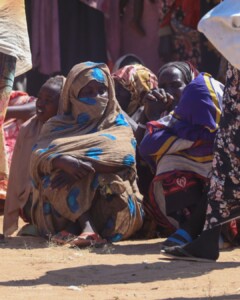OCHA Sudan: Malaria breached epidemic threshold in 2019
More than 1.8 million cases of malaria were reported from across Sudan so far in 2019, a sharp increase compared to previous years, the UN Office for the Coordination of Humanitarian Affairs (OCHA) reported on Thursday. Cases of diphtheria, dengue fever, rift valley fever, chikungunya, and cholera continue to be recorded across the country, according to the Sudanese Ministry of Health.
 A patient at El Sareif Hospital in North Darfur (Albert González Farran/Unamid)
A patient at El Sareif Hospital in North Darfur (Albert González Farran/Unamid)
More than 1.8 million cases of malaria were reported from across Sudan so far in 2019, a sharp increase compared to previous years, the UN Office for the Coordination of Humanitarian Affairs (OCHA) reported on Thursday. Cases of diphtheria, dengue fever, rift valley fever, chikungunya, and cholera continue to be recorded across the country, according to the Sudanese Ministry of Health.
UN OCHA Sudan stated in its latest Situation Report, that malaria now accounts for 12.4 per cent of all diseases surveyed by the health sector in the country (measles, dysentery, typhoid fever, acute watery diarrhoea, respiratory infections etc.) – with a mortality rate of 13 per 10,000.
This is a 30 per cent increase compared to the same period last year, OCHA says. Large parts of Darfur, White Nile state, Khartoum are affected most.
In November alone, about 250,000 cases of malaria were reported from Darfur, according to the Sudanese Ministry of Health. This includes about 110,000 reported malaria cases in South Darfur, 103,000 cases in North Darfur, and about 45,000 cases in East Darfur.
The Ministry and the World Health Organisation (WHO) are leading a country-wide comprehensive response to vector-borne disease outbreaks (malaria, dengue fever and chikungunya) covering 10 states, including the five states of Darfur.
The rise in malaria cases is closely related to the floods in Sudan this year. The widespread presence of stagnant floodwaters offers breeding grounds for mosquitoes—which transmit the malaria parasite. These breeding grounds pose a further risk for other vector-borne diseases such as yellow fever and dengue.
Shortage of medicines
According to the Essential Medicine, Availability and Affordability Survey in Sudan, implemented by the Health Ministry and WHO in July, medicine availability varied from 43 per cent at the National Medical Supply Fund, 49 per cent at the National Health Insurance Fund, and 59 per cent in the private sector.
The availability of medicines in 2019 was the lowest both in public and private sectors since 2012, according to the survey. According to the Central Bank of Sudan statistics, during January-September 2018, Sudan’s imports of medicines dropped by 35 per cent compared to the same period of 2017. The level of medicine imports in 2019 remains similar to last year, and is 34 per cent lower compared to the same period of 2017.
The lack of medicines, particularly at primary health clinics, are having a negative impact on treatments available in clinics. This is increasing the pressure on clinics and other health facilities run by NGO partners where medicines and treatment are more easily available, OCHA reported.
Health report
On Thursday, Sudan’s Health Ministry further reported that since the outbreaks in August, 3,974 dengue fever cases (11 deaths), 368 Rift Valley fever cases (11 deaths), 238 chikungunya cases (five deaths), 344 cholera cases (11 deaths), and 72 cases of diphtheria (including 12 deaths) have been recorded.
A medical source told Radio Dabanga that one person died of dengue fever and 21 new cases were recorded in Kassala town on Thursday.
Our editorial independence means that we can continue to provide factual updates about political developments to Sudanese and international actors, educate people about how to avoid outbreaks of infectious diseases, and provide a window to the world for those in all corners of Sudan. Support Radio Dabanga for as little as €2.50, the equivalent of a cup of coffee.












 and then
and then